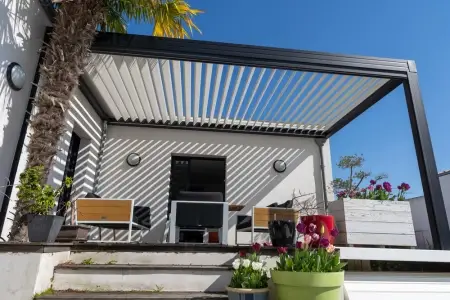
Passive solar energy is based on the direct use of solar radiation, without the need to use external support mechanisms, such as electric motors to orient solar panels or other similar systems. The main objective of this type of renewable energy is to achieve natural thermal comfort in spaces without resorting to external energy sources. Sometimes, passive solar systems are combined with active technologies, such as the installation of photovoltaic panels, to maximize energy efficiency.
In order to take advantage of passive solar energy, it is essential to carry out a series of energy exchanges, in which solar energy is transferred from one system to another. An example of this is the transfer of heat from solar radiation to a water tank, which is used to heat the water and obtain domestic hot water.
This transfer of thermal energy occurs through three fundamental thermodynamic processes: radiation , conduction and convection . These concepts are explained below:
Heat transfer by conduction
 Heat transfer by conduction is based on the transport of heat from one body to another through a conductive medium, which can be air or water. In the field of passive solar energy, conduction through air is particularly relevant.
Heat transfer by conduction is based on the transport of heat from one body to another through a conductive medium, which can be air or water. In the field of passive solar energy, conduction through air is particularly relevant.
In terms of passive solar energy, thermal conduction can be both beneficial and detrimental. In winter, for example, we need to harness heat, while in summer too much heat can lead to uncomfortable temperatures inside spaces. In addition, uncontrolled infiltration of cold air can contribute up to 40% of heat loss in winter.
Correct placement of windows and ventilation systems can enhance natural convection, promoting cross ventilation and cooling during warmer months.
Energy recovery ventilation systems are essential as they can remove moisture, dust, pollen and unwanted microorganisms from the air without the need for energy-intensive filtration systems.
Natural convection, which causes warm air to rise and cool air to fall, can lead to uneven heat stratification, which could lead to uncomfortable temperature variations in spaces. However, this stratification can also be used as a method of venting warm air, or even as an airflow circuit to passively distribute solar heat.
Convection heat transfer
 Convective heat transfer is based on the thermal exchange between two bodies at different temperatures that are in contact. This process is governed by the first principle of thermodynamics.
Convective heat transfer is based on the thermal exchange between two bodies at different temperatures that are in contact. This process is governed by the first principle of thermodynamics.
A common example of this process is when we touch a hot radiator with our hand. At that moment, heat is transferred from the radiator (warmer) to our hand (colder) by convection.
In buildings constructed under the principles of passive architecture, it is crucial to use materials with a high thermal insulation capacity. Thermal bridges at the junctions of exterior doors and windows must be avoided to ensure the energy efficiency of the system.
Heat transfer by radiation
 Radiative heat transfer occurs through electromagnetic waves, without the need for a conductive medium. This is the mechanism by which solar energy reaches the Earth from the Sun, traveling through the vacuum of space.
Radiative heat transfer occurs through electromagnetic waves, without the need for a conductive medium. This is the mechanism by which solar energy reaches the Earth from the Sun, traveling through the vacuum of space.
Solar radiation is absorbed primarily through windows and roofs. Thermal energy is transferred from warm to cold surfaces, allowing the home to heat up naturally during the day. However, at night, this same radiation can escape through the same surfaces.
On cold, clear days, solar radiation is essential for heating. To control the heat entering through windows, it is possible to reduce it by using insulating glass, adequate shading and correct orientation of the windows.
Solar radiation not only provides heat, but also light. To prevent overheating in summer, shading can be provided by eaves, blinds or shade trees that lose their leaves in autumn, allowing better use of sunlight during winter.
An essential principle of passive solar design is the storage of thermal energy in certain building materials, which helps to stabilise diurnal temperature variations. These materials release the stored energy during the night or at times of increased thermal demand.